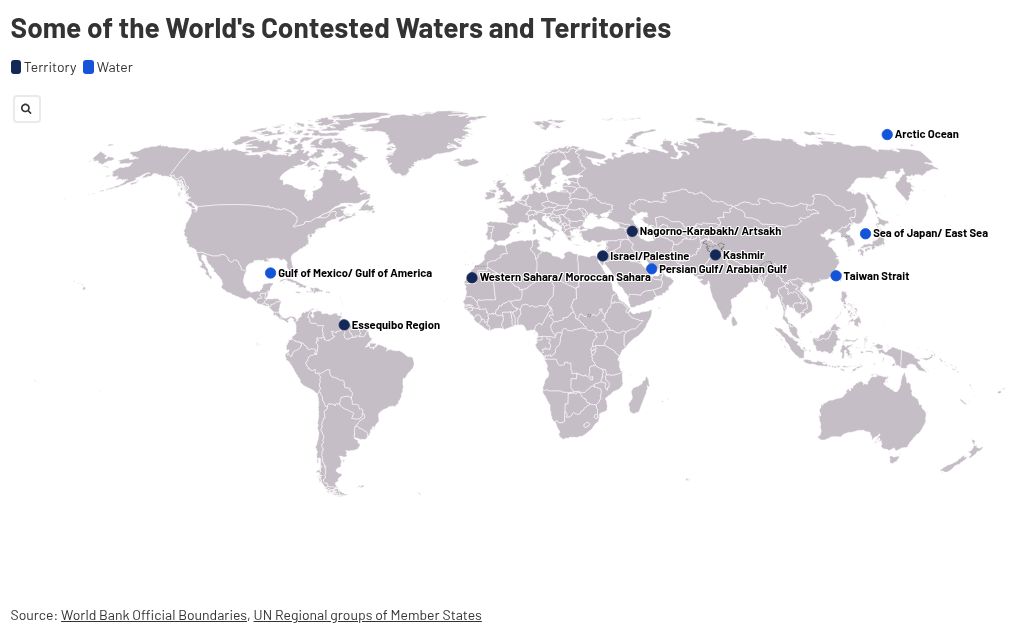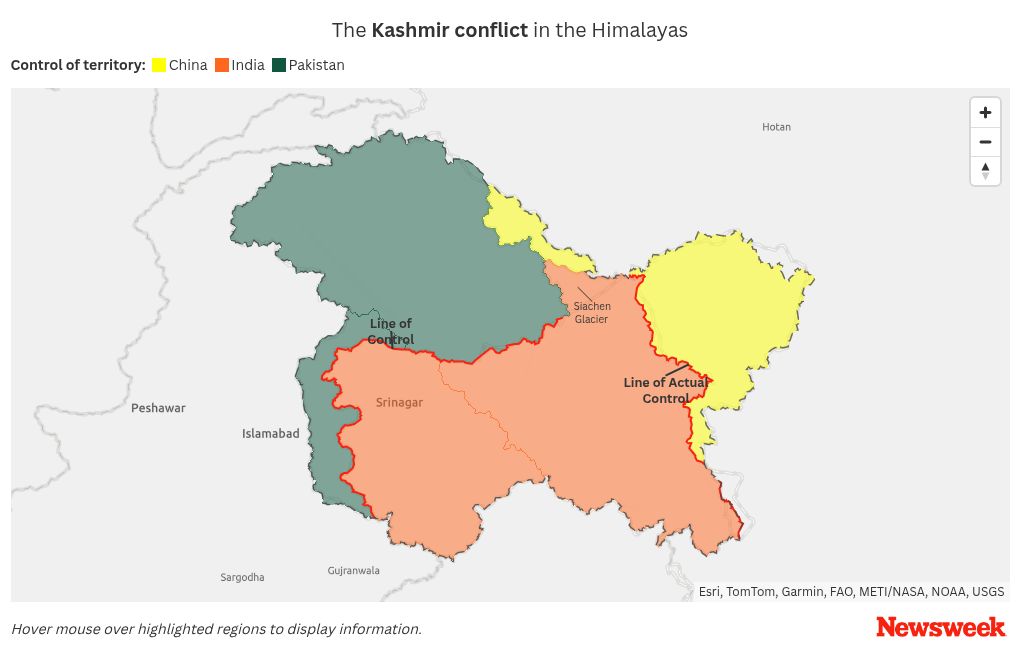Twice in the past three months, the White House has taken interest — and action — in unilaterally renaming some of the world’s bodies of water.
As part of his “America First” doctrine, President Donald Trump rechristened the Gulf of Mexico as the “Gulf of America” as one of his first executive orders after the inauguration. The move, dismissed by critics as symbolic and widely unpopular in polls, has had ripple effects. It sparked swift consequences for the media, with the Associated Press suing after the agency was barred from the White House press pool over refusing to use the new name. Google opted to go the other way, changing the centuries-long name on its mapping products. Google said it adapts its labels to language and location settings, echoing local preferences.
But even more than a cartographic tweak, Trump’s focus on geographical names has tapped into the deep currents driving territorial disputes around the world for centuries: nationalism, authority, historical memory and cultural identity.
Now, amid already escalating tensions with Iran, the White House appears ready to wade even deeper into the naming wars, with reports that the administration may push to rebrand the Persian Gulf as the “Arabian Gulf.” The U.S. never formally considered such a move, even during the Iranian hostage crisis and collapse of diplomatic relations following the 1979 Iranian Revolution.
Territorial and maritime disputes are nothing new, stretching back centuries through the rise and fall of empires. Some, like the Israel-Palestine conflict, receive more media attention than others, like Western Sahara and Morocco. Dozens of borderlands and bodies of water remain contested across the globe, often simmering with tension, and sometimes outright conflict.
These disputes are rarely just about geography. While the regions in question often hold material or strategic value, the battles over naming and borders are deeply entangled with cultural identity, national pride and the weight of regional history.
Some Notable Contested Waterways
Outside of the region, the sea between the Arabian Peninsula and Iran is most widely known as the Persian Gulf. However, the body of water takes on the name Arabian Gulf among its neighboring Arab countries. The Gulf is a major oil exporter, with the fossil fuel then funneling through Iran’s Strait of Hormuz to the rest of the world, raising the weight of its geopolitical assertions.
The Trump administration’s reported proposal to rename the Persian Gulf has drawn swift outrage from Iranians at home and across the diaspora, while finding favor among Arab states. For many Iranians, the name is a source of national pride and a symbolic link to the country’s unique legacy of the Persian Empire in a region surrounded by Arab neighbors. The Arabian Gulf, they say, could also create confusion with the nearby Arabian Sea, the northern region of the Indian Ocean.
The sea bordered by North and South Korea, Japan, and Russia is also the subject of a naming dispute—with Japan insisting it be called the “Sea of Japan,” while South Korea advocates for the more inclusive “East Sea.” The name the Sea of Japan rose to prominence during Japan’s imperial era, including its 35-year colonization of Korea. Tokyo maintains that it was present in maps before then.
The legacy and associations of the name leads South Korea to view the term as a colonial remnant of Japan’s imposed rule on the nation. East Sea, they say, also appeared in ancient documents.
Also in Asia, the Taiwan Strait remains contested, with China claiming that it has “sovereignty, sovereign rights, and jurisdiction” over the 110-mile-wide Strait, a strategic waterway that links the East China Sea with the South China Sea. Taiwan, which the U.S. does not formally recognize as an independent country but does maintain a security partnership, rejects Beijing’s claim, insisting the strait constitutes international waters.
Several parts of the Arctic Sea are disputed by a host of actors, including the U.S., Canada, Denmark (via Greenland) and Russia. All of those countries have territorial seas extending out from their coasts, but there are contentions among passageways and dividers like the Lomonosov Ridge, an underwater mountain range claimed by Denmark, Canada and Russia.

Some of the World’s Disputed Territories
Across the globe, territorial disputes range from local skirmishes to major standoffs marked by dashed lines on maps and deep-rooted claims of sovereignty. Perhaps the most visible and widely discussed dispute over the past few years has been between Israel and the Palestinian territories.
In contested spaces around the world, rival governments, actors, and movements continue to press their claims, often stoking unrest and reshaping geopolitics. Some of the disputed areas are marked by foreign rule, while others face mass displacement, sprawling refugee camps, or widespread persecution and discrimination.
Western Sahara
The larger region of Western Sahara, which Morocco refers to as “Moroccan Sahara,” was colonized by Spain in the 14th century. A string of border conflicts has shaped the region’s modern history, including the 1963 Sand War between Algeria and Morocco and Morocco’s 1975 “Green March,” when thousands of civilians, backed by the Moroccan military, advanced into the disputed territory of Western Sahara.
The March, and the Madrid Accords agreement between Spain, Morocco and Mauretania that followed, signified regime change and the forceful displacement of majority of Sahrawis, many of whom now live in refugee camps in Algeria.
The Saharawi Arab Democratic Republic (SADR) still declares sovereignty over the region. Morocco, which also claims its sovereignty over the area, has constructed the second-largest wall in the world, known as the Berm, a military sand wall that divides the area into the SADR and Occupied Territories. The region notably has phosphate mines and fish-rich waters. Over the past several decades, since the Spanish colonial era, the region has seen flashpoints of violence.
The U.N. does not recognize Morocco’s sovereignty claims, labeling it as a non-self-governing territory, while 47 U.N. member countries recognize SADR’s independence.
Kashmir
Further east, fresh clashes between India and Pakistan have thrust Kashmir back into the spotlight. Kashmir, high in the Himalayas, is home to some 13 million people in total—about seven million in India-administered regions and six million in Pakistan-administered regions. India and Pakistan both claim the area in its entirety, while China is a third, albeit minor, party to the conflict over the resource-rich territory.

India governs about 55 percent of the area of Kashmir in the center and south, including the densely populated and fertile lands of the Kashmir Valley. Pakistan controls 30 percent, predominantly in the northwest, while China holds the remaining 15 percent in the northeast. The “Line of Actual Control” measures over 2,000 miles in total and includes disputed central and and eastern sectors where India’s northern states meet Chinese-controlled Tibet.
The Kashmir conflict dates back to 1947, when British colonial rule in India ended and the subcontinent was partitioned into the sovereign states of India and Pakistan. Jammu and Kashmir, a region now administered by India and known as J&K, chose to accede to India after tribal militias backed by Pakistan moved in, leading to the first Kashmir war between the neighbors.
A ceasefire was brokered by the U.N. in 1949, but war broke out again in 1965 after an infiltration by Pakistani forces into J&K prompted multiple Indian offensives. Despite thousands of casualties, another ceasefire left positions largely unchanged.
Indian and Pakistani armed forces fought three major wars over Kashmiri territory in the last century, but the fragile boundaries have seen numerous skirmishes and an ongoing insurgency in India-administered areas. Pakistan rejects Indian accusations that it supports the insurgents, but says it offers moral support for Kashmiri self-determination.
Nagorno-Karabakh
Known as Artsakh to Armenians, Nagorno-Karabakh is a mountainous region in the South Caucuses that has been at the center of a decades-long dispute between Armenia and Azerbaijan. The region is home to a majority ethnic Armenian population. Tensions escalated following the dissolution of the Soviet Union, and in 1988 the regional parliament of the area voted to unify with Armenia, with forces then taking control of the area located inside Azerbaijan.
In recent years, Azerbaijan’s military action retook large portions of the territory, leading thousands of Armenians to flee and face persecution.
Essequibo Region
The territorial dispute between Guyana and Venezuela over the resource-rich Essequibo region, home to prized offshore oil reserves and rich in gold and timber, escalated in recent years with Venezuela’s troop buildup on the border.
Venezuela claims the western two-thirds of Guyana based on its Spanish colonial past, but an 1899 international tribunal ruling awarded the land to then-British Guiana. Guyana says the region is home to about 125,000 of its citizens.
Tensions have grown significantly in recent years, coinciding with oil discoveries in 2015. In 2018, Guyana brought border dispute to the International Court of Justice (ICJ), where it is still pending.
However, the court ordered last week that Venezuela should refrain from holding planned elections in the disputed territory on May 25. Caraacas rejected that order and plans to go ahead with the vote.
The post Lines in the Sand and Sea: Some of the World’s Contested Names and Regions appeared first on Newsweek.




